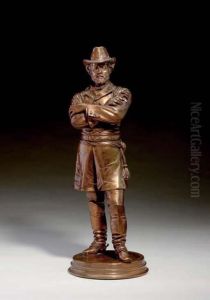Alexander Doyle Paintings
Alexander Doyle was an American sculptor born in 1857 in Steubenville, Ohio. He hailed from a family with artistic roots; his grandfather was a noted marble cutter in Ireland, and his uncle, Henry Doyle, was a prominent figure in the arts in California. These familial connections played a significant role in shaping Doyle's career and aspirations in the world of art.
Doyle's education in the arts began under the tutelage of his father, a stone cutter, which provided him with a foundational understanding of sculpting from a young age. His passion and talent for sculpture soon led him to pursue formal education in this field. In pursuit of mastering his craft, Doyle traveled to Italy, a country renowned for its rich history in sculpture and art. There, he studied at the prestigious Accademia di Belle Arti in Florence, immersing himself in the study of classical and Renaissance art. This period was crucial in honing his skills and aesthetic sensibilities, deeply influencing his later work.
Upon returning to the United States, Doyle quickly established himself as a talented sculptor. He became known for his bronze and marble statues, many of which were commissioned to commemorate notable figures in American history. His works include statues of Thomas Jefferson at the University of Virginia, designed by the renowned American architect Thomas Jefferson himself, and a statue of George Washington, showcasing his ability to capture both the physical likeness and the spirit of his subjects. Doyle's sculptures are characterized by their classical style, attention to detail, and the emotional depth they convey, traits that made him a sought-after artist during his time.
Throughout his career, Doyle contributed significantly to the American neo-classical movement, leaving a lasting legacy through his public monuments and private commissions. Despite facing the challenges of a changing art world with the rise of modernism, Doyle's work remained respected and admired for its craftsmanship and adherence to classical beauty. He passed away in 1922, leaving behind a body of work that continues to be celebrated for its contribution to American sculpture and its embodiment of the nation's cultural heritage. Alexander Doyle's life and work exemplify the enduring appeal of classical art in the modern era, marking him as a significant figure in the history of American sculpture.
